
Having land in Upstate New York is a dream for many, especially in picturesque areas like Canandaigua, Rush, or Macedon. But how do you make the most of that piece of paradise once you have it? Many landowners ponder, "I want to build a house on my land; where do I start?" If that's you, here's a step-by-step guide to help you navigate the exciting journey of turning your raw land into a beautiful custom home.
Table of Contents
- Overview: How to Build a House on Your Land in Upstate NY
- How Do I Know If I Can Build a House on My Land in New York?
- Steps for Building on Your Land in Upstate New York
- Checklist for Landowners to Assess Their Land for Building
- Pro Tips for Building on Your Land in Upstate New York
- Utilities & Septic: What If My Land Is “Raw”?
- Building on Land You Already Own vs. Buying Land Now & Building Later
- FAQs: Building on Your Land in Upstate NY
Overview: How to Build a House on Your Land in Upstate NY
Need to see the quick steps first? Here's the general overview.
-
Survey & Zoning Check – Confirm property lines, setbacks, and local building requirements.
-
Assess Site Conditions – Include soil tests, septic vs. sewer, utilities, driveway access, slope, and drainage.
-
Set a Budget – Include site prep, permits, construction, finishes, and a contingency.
-
Choose a Plan & Builder – Work with a local builder familiar with Monroe, Ontario, and Wayne County requirements.
-
Secure Financing – Explore construction-to-permanent loans or builder financing guidance.
-
Get Permits & Approvals – You'll need municipality review for building, septic, and utility connections.
-
Prepare the Land – This is clearing, grading, utilities, and foundation work.
-
Build Your Custom Home – Time to go from framing to finishes, guided by your builder.
How Do I Know If I Can Build a House on My Land in New York?
Most landowners in Monroe, Ontario, and Wayne Counties can build a home on their property, but a few local checks come first. Zoning laws, setbacks, and environmental restrictions (such as wetlands or flood zones) can affect what type of home you can build and where it sits on the lot. Utility access is another major factor: does your land connect to public water and sewer, or will you need a well and septic system?
Local requirements vary by town. For example, Pittsford and Webster (Monroe County) may have different setback or utility requirements than Canandaigua (Ontario County) or Macedon (Wayne County). That’s why a site assessment and zoning check are essential before you start designing your home.
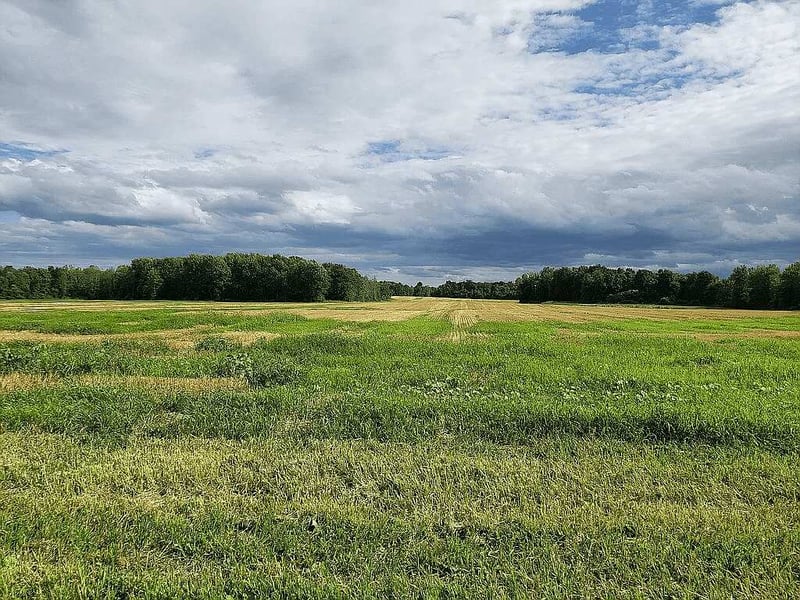
Steps for Building on Your Land in Upstate New York
Every property in Upstate New York is unique: soil types, access roads, zoning rules, and even seasonal drainage can affect what’s possible on your site. Getting these early steps right helps you avoid expensive surprises later and sets a clear path for your project. Here are the first big items to review with your builder.
Assess Your Land
Before anything else, take inventory of your land. This means looking beyond the size of the lot and considering key details tied to land and lot development:
-
Topography: Is the land flat, gently sloping, or steep? A hillside in Canandaigua may require retaining walls or a walkout basement design, while a flat lot in Webster might be ready for a slab-on-grade.
-
Soil Quality: Clay, sand, and rock all affect drainage and the type of foundation you’ll need. A professional soil test (perc test) is especially important if you’ll need a septic system.
-
Utilities & Access: Does the property connect to public water, sewer, and electricity, or will you need a well, septic tank, or trenching for electric lines? Even driveway length matters. Long access roads can increase site costs.
-
Zoning & Restrictions: Local towns and villages in Monroe, Ontario, and Wayne Counties may have setback rules, easements, or environmental protections. For example, some Ontario County parcels border wetlands that require extra review.
Set a Budget
You already have the land, but how much will it cost to build? Working with an experienced “build on your lot” builder helps you translate raw numbers into a line-item estimate based on your specific property. A realistic budget should include:
-
Site Work: Clearing trees, grading, adding fill, or building an access driveway.
-
Utilities: Well drilling, septic installation, or extending public water/sewer connections.
-
Permits & Fees: Local building permits, impact fees, or inspections.
-
Home Construction: The actual build costs, which vary depending on floor plan, size, and finishes.
-
Landscaping & Outdoor Features: Driveways, patios, and grading around the foundation.
-
Contingency Fund: Unexpected soil conditions, rock removal, or design changes can add 10–15% to total costs.
Want to dive deeper into the process? Check out our custom home building guide for step-by-step insights and practical tips to help you plan with confidence.
Stay Informed on Land Value
Land is a substantial but wise investment. In Upstate New York, communities like Victor, Pittsford, and Macedon continue to see growth, making well-located land a valuable asset. Some key points to keep in mind:
-
Market Trends: Tracking property values helps you decide whether to build now or hold the land longer.
-
Build Now vs. Later: Waiting can sometimes increase equity, but it can also expose you to rising construction costs.
-
Seasonal Insights: Owning the land for a year before building lets you see how it handles spring runoff, winter access, and sunlight, all invaluable info for siting your home.
.jpeg?width=800&height=600&name=Exterior%20view%20of%20construction%20progress%20on%20Rochester%20custom%20home%20(1).jpeg)
Plan Your Timeline
Timing is one of the most overlooked factors in building on your own land. The custom home construction process often spans 12–18 months from design through move-in. The exact timeline depends on your property, the complexity of your home, and local permitting. Consider these timing factors.
-
Design & Permits: Architectural design, engineering, and municipal approvals can take several months before construction begins and having a clear grasp of the early steps in Rochester area home building prep can make the process feel far less overwhelming.
-
Site Preparation: Clearing, grading, utilities, and foundation work are weather-dependent. In Upstate New York, winter conditions can extend schedules if not planned well.
-
Seasonal Benefits: Living on (or observing) your land through spring runoff, summer sun, fall foliage, and winter snow can give you valuable insights into drainage, best building sites, and where to capture the best views.
-
Financial Readiness: Waiting to build may allow you to save more funds or take advantage of favorable interest rates, but construction costs also tend to rise over time.
Choose a Reputable Builder
Perhaps the most important decision you’ll make is selecting the right builder to bring your vision to life. A reputable, local “build on your lot” builder understands not only the construction process, but also the unique challenges of building in Upstate New York. Here's what to look for in a builder.
-
Local Experience: Knowledge of Monroe, Ontario, and Wayne County zoning, permitting, and inspection requirements.
-
Site Work Expertise: Ability to anticipate hidden costs like drainage, septic, or driveway challenges.
-
Transparent Process: Clear communication about budgets, timelines, and design flexibility.
-
Proven Portfolio: Completed homes in communities similar to yours, with client testimonials to back them up.
Explore the benefits of talking to a builder before designing your dream home.
Site Prep on Raw Land: How to Get Build-Ready
Transforming a piece of land into a build-ready site is no small task. It's a meticulous process that requires the expertise of experienced contractors to ensure that the land not only looks good but is structurally sound for construction. Homeowners can benefit from reviewing the steps to take before building a house on raw land to get a clear picture of what this process involves and whether it’s the right path for their property.
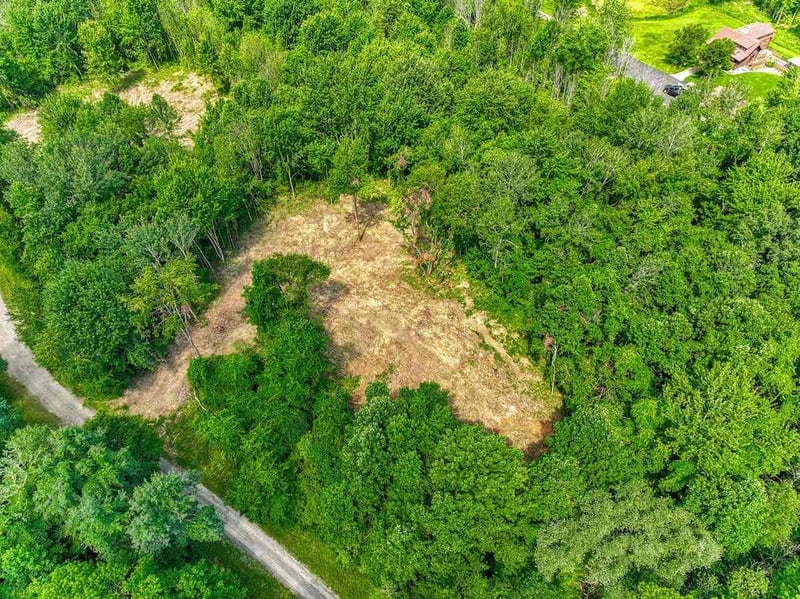
Site Assessment & Surveying
A surveyor confirms property boundaries, checks the topography, and maps out natural features such as slopes, wetlands, rock outcrops, or other potential obstructions. This step helps determine where your home can and should be placed.
Soil Testing
Engineers take soil samples to test stability, drainage, and load-bearing capacity. In Upstate New York, this often includes a perc test to determine whether the soil can support a septic system.
Clearing and Grubbing
This is where visible changes start occurring. Trees, brush, and vegetation are removed. Grubbing ensures roots and stumps don’t interfere with grading or foundations later.
Access Development
Contractors will establish a temporary road or access path for machinery and materials to reach the building site. This is crucial, especially in remote areas.

Site Leveling and Grading
Depending on the house’s design and the land's natural topography, the ground may need to be leveled. Proper grading ensures efficient water drainage and prevents potential flooding issues.
Utility Installation
If the plot isn't connected to local utilities like water, electricity, gas, and sewage, contractors will need to lay the necessary infrastructure. This might involve digging wells, installing septic tanks, or trenching for electrical and water lines.
Foundation Preparation
Finally, the site is excavated for the foundation. Depending on soil conditions and home design, this could involve footings, a basement, a slab, or a crawl space. Once complete, the lot is ready for vertical construction.
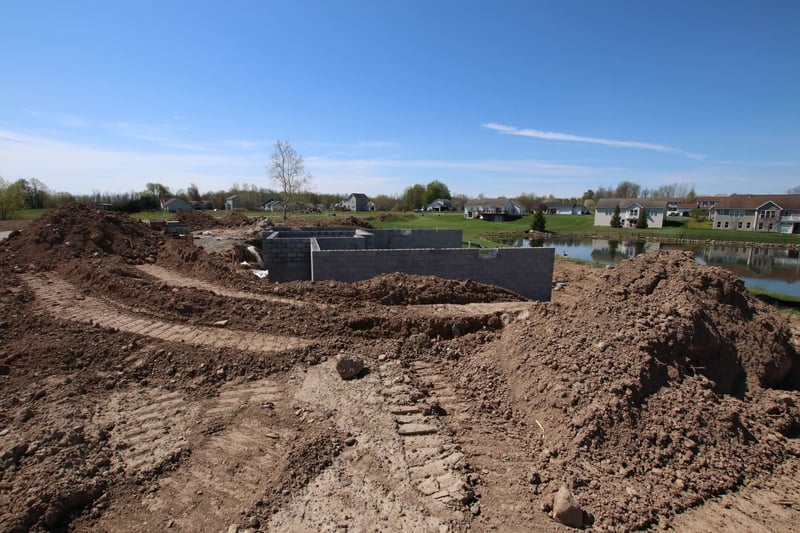
Checklist for Landowners to Assess Their Land for Building
Discover key factors to evaluate when selecting the perfect land to buy and build your custom home in Upstate New York.
-
Natural Resources: Examine the existing trees, water bodies, or rock formations. How do these fit into your vision? What might need to be removed or altered?
-
Utility Access: Is your land already connected to electricity, water, and sewage lines? If not, factor in the costs and logistics of setting these up.
-
Soil Quality: Even if a contractor will do a detailed analysis, having a basic understanding of your land's soil can be beneficial. Is it rocky? Clayey? Sandy?
-
Topography: Assess the general lay of the land. Is it hilly, flat, or sloped? This can influence design decisions and construction techniques.
-
Sunlight and Wind Patterns: Understanding where sunlight hits the most or from where winds predominantly blow can help in optimizing energy costs and ensuring comfort.
-
Neighboring Properties: Look around. Are there other homes or facilities nearby? Who owns vacant land and how is it zoned? Their presence (or lack thereof) can impact your decisions on privacy, design, and more.
Pro Tips for Building on Your Land in Upstate New York
Upstate New York’s climate and terrain bring unique considerations for landowners. Keep these in mind as you plan your build on your own land.
-
Frost Depth: Foundations here must extend below the frost line (typically 42–48 inches) to prevent shifting from freeze-thaw cycles.
-
Drainage: Spring snowmelt and heavy rains make proper grading critical. Poor drainage can lead to basement leaks or foundation stress.
-
Snow Access: Long driveways and rural roads need to be planned for winter plowing. Think about slope, turnaround space, and accessibility for emergency vehicles.
-
Driveway Durability: Freeze-thaw cycles can crack thin pavement or gravel. A well-prepared base layer keeps your driveway usable year-round.
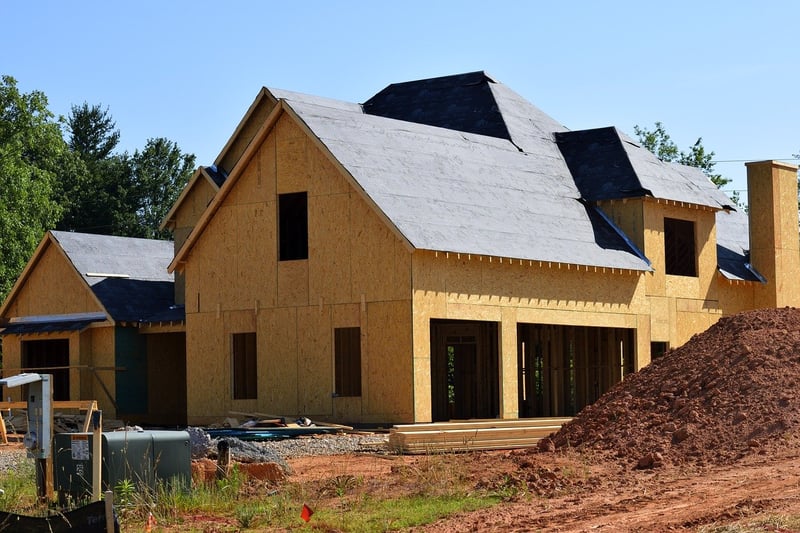
Utilities & Septic: What If My Land Is “Raw”?
If your property doesn’t have existing connections, don’t worry! Most raw land can still be developed with the right planning. The process comes down to public vs. private systems and who handles installation.
Connecting to Public Utilities
In more developed areas of Monroe and Ontario Counties, you may be able to connect to municipal water, sewer, and electricity. This usually involves trenching lines from the nearest connection point, installing meters, and paying connection fees.
Creating Private Residential Utility Systems
For rural properties (common in Wayne County and parts of Ontario County), you may need:
-
-
A well for water supply.
-
A septic system designed and permitted based on your soil’s perc test.
-
Propane or fuel oil if natural gas isn’t available.
-
-
Who Handles It: Your builder coordinates with licensed contractors to install these systems. Gerber Homes manages this process as part of site prep, so you’re not left guessing what’s needed.
Building on Land You Already Own vs. Buying Land Now & Building Later
One of the most common questions we hear is: Should I build right away or wait? The answer depends on your personal situation and your land.
The Case for Building Now
-
Lock in today’s construction costs before they rise.
-
Begin enjoying your land and your new home sooner.
-
Easier to finance when land and home are part of the same package.
When Building Later Makes Sense
-
Gives you more time to save money or build equity.
-
Lets you observe your land through all four seasons, learning about drainage, sun exposure, and access.
-
Can be wise if you expect local property values to increase.
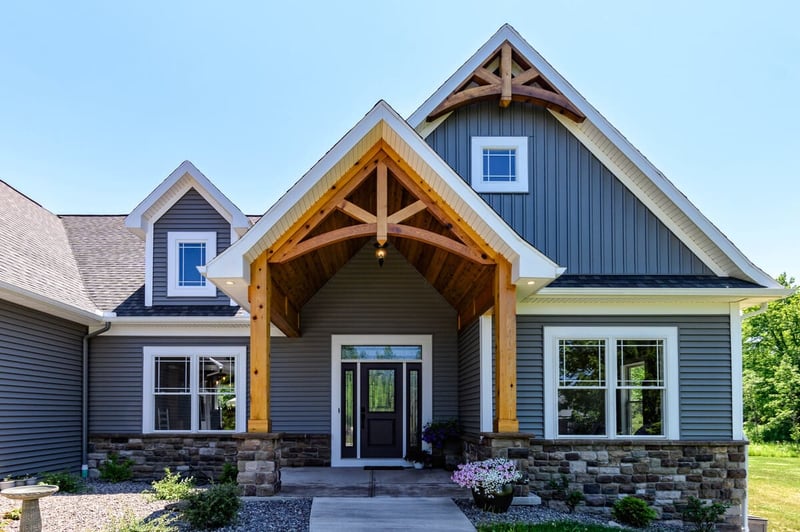
FAQs: Building on Your Land in Upstate NY
How do I start building a house on my land?
Start with a homesite assessment to evaluate zoning, utilities, and site conditions. From there, you can choose a plan, set a budget, and begin design.
Can I build a house on land I own in New York?
Yes! Provided your property meets local zoning, setback, and utility requirements. A builder can help you navigate municipal approvals.
What are the steps to build on raw land?
Survey → soil/perc test → clearing → grading → utilities → foundation → construction.
How long does the home construction process take?
Design, permitting, and construction together often take 12–18 months. Seasonal conditions in Upstate NY can influence schedules.
Do you help find land if I don’t have it yet?
Yes! Working with Gerber Homes means having a partner who can connect you with available lots and help evaluate parcels before you buy.
Ready to Build in Monroe, Ontario, or Wayne County?
The journey from owning land to having a home on it is thrilling. Understanding the steps and partnering with the right professionals can make all the difference. If you have any more questions or if you're ready to start building in Upstate New York, Contact us here. Gerber Homes is ready to assist you every step of the way.







.png)
